child restraint FORD EDGE 2013 1.G Owners Manual
[x] Cancel search | Manufacturer: FORD, Model Year: 2013, Model line: EDGE, Model: FORD EDGE 2013 1.GPages: 526, PDF Size: 5.98 MB
Page 1 of 526
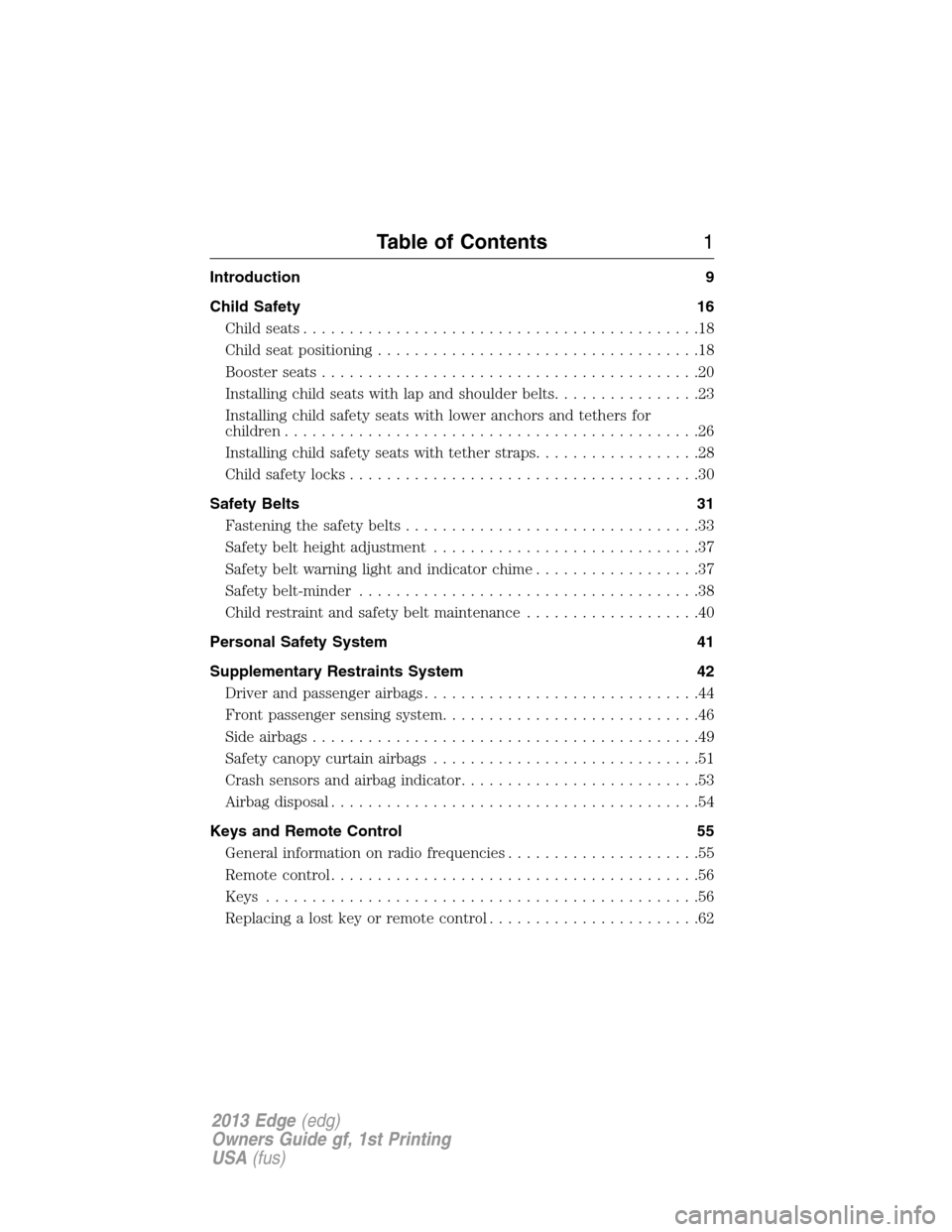
Introduction 9
Child Safety 16
Child seats...........................................18
Child seat positioning...................................18
Booster seats.........................................20
Installing child seats with lap and shoulder belts................23
Installing child safety seats with lower anchors and tethers for
children.............................................26
Installing child safety seats with tether straps..................28
Child safety locks......................................30
Safety Belts 31
Fastening the safety belts................................33
Safety belt height adjustment.............................37
Safetybeltwarninglightandindicatorchime..................37
Safety belt-minder.....................................38
Child restraint and safety belt maintenance...................40
Personal Safety System 41
Supplementary Restraints System 42
Driver and passenger airbags..............................44
Front passenger sensing system............................46
Side airbags..........................................49
Safety canopy curtain airbags.............................51
Crash sensors and airbag indicator..........................53
Airbag disposal........................................54
Keys and Remote Control 55
General information on radio frequencies.....................55
Remote control........................................56
Keys...............................................56
Replacing a lost key or remote control.......................62
Table of Contents1
2013 Edge(edg)
Owners Guide gf, 1st Printing
USA(fus)
Page 16 of 526
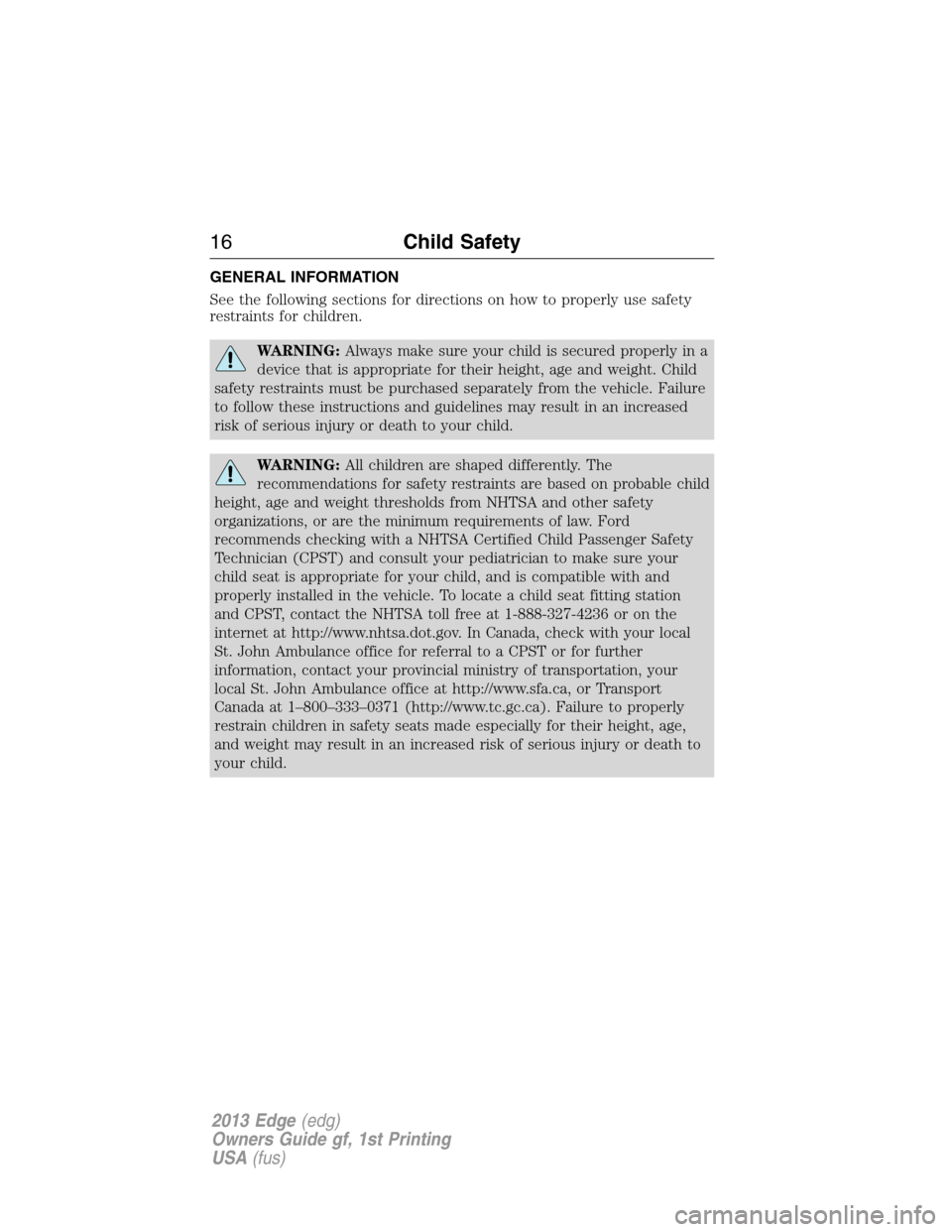
GENERAL INFORMATION
See the following sections for directions on how to properly use safety
restraints for children.
WARNING:Always make sure your child is secured properly in a
device that is appropriate for their height, age and weight. Child
safety restraints must be purchased separately from the vehicle. Failure
to follow these instructions and guidelines may result in an increased
risk of serious injury or death to your child.
WARNING:All children are shaped differently. The
recommendations for safety restraints are based on probable child
height, age and weight thresholds from NHTSA and other safety
organizations, or are the minimum requirements of law. Ford
recommends checking with a NHTSA Certified Child Passenger Safety
Technician (CPST) and consult your pediatrician to make sure your
child seat is appropriate for your child, and is compatible with and
properly installed in the vehicle. To locate a child seat fitting station
and CPST, contact the NHTSA toll free at 1-888-327-4236 or on the
internet at http://www.nhtsa.dot.gov. In Canada, check with your local
St. John Ambulance office for referral to a CPST or for further
information, contact your provincial ministry of transportation, your
local St. John Ambulance office at http://www.sfa.ca, or Transport
Canada at 1–800–333–0371 (http://www.tc.gc.ca). Failure to properly
restrain children in safety seats made especially for their height, age,
and weight may result in an increased risk of serious injury or death to
your child.
16Child Safety
2013 Edge(edg)
Owners Guide gf, 1st Printing
USA(fus)
Page 17 of 526
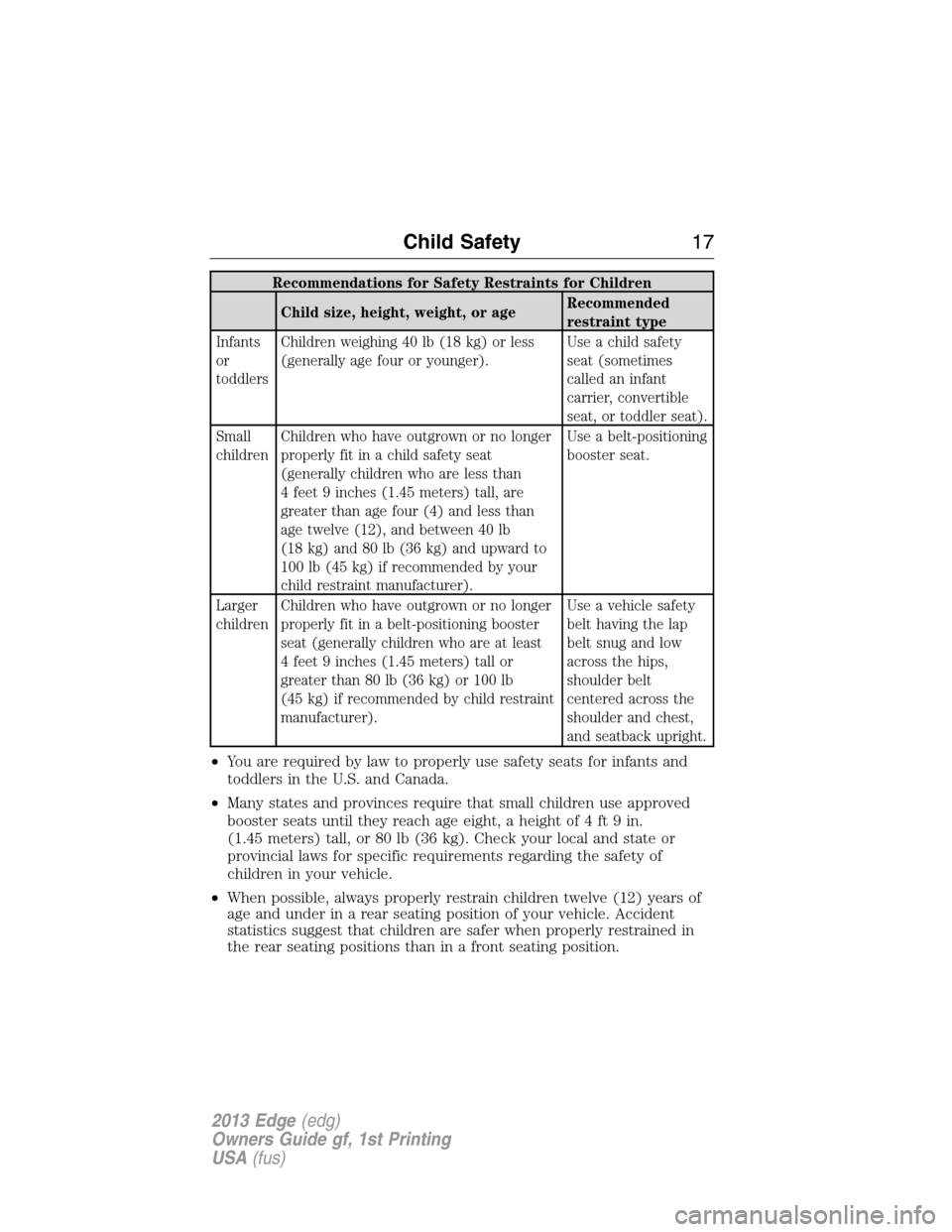
Recommendations for Safety Restraints for Children
Child size, height, weight, or ageRecommended
restraint type
Infants
or
toddlersChildren weighing 40 lb (18 kg) or less
(generally age four or younger).Use a child safety
seat (sometimes
called an infant
carrier, convertible
seat, or toddler seat).
Small
childrenChildren who have outgrown or no longer
properly fit in a child safety seat
(generally children who are less than
4 feet 9 inches (1.45 meters) tall, are
greater than age four (4) and less than
age twelve (12), and between 40 lb
(18 kg) and 80 lb (36 kg) and upward to
100 lb (45 kg) if recommended by your
child restraint manufacturer).Use a belt-positioning
booster seat.
Larger
childrenChildren who have outgrown or no longer
properly fit in a belt-positioning booster
seat (generally children who are at least
4 feet 9 inches (1.45 meters) tall or
greater than 80 lb (36 kg) or 100 lb
(45 kg) if recommended by child restraint
manufacturer).Use a vehicle safety
belt having the lap
belt snug and low
across the hips,
shoulder belt
centered across the
shoulder and chest,
and seatback upright.
•You are required by law to properly use safety seats for infants and
toddlers in the U.S. and Canada.
•Many states and provinces require that small children use approved
booster seats until they reach age eight, a height of 4 ft 9 in.
(1.45 meters) tall, or 80 lb (36 kg). Check your local and state or
provincial laws for specific requirements regarding the safety of
children in your vehicle.
•When possible, always properly restrain children twelve (12) years of
age and under in a rear seating position of your vehicle. Accident
statistics suggest that children are safer when properly restrained in
the rear seating positions than in a front seating position.
Child Safety17
2013 Edge(edg)
Owners Guide gf, 1st Printing
USA(fus)
Page 18 of 526
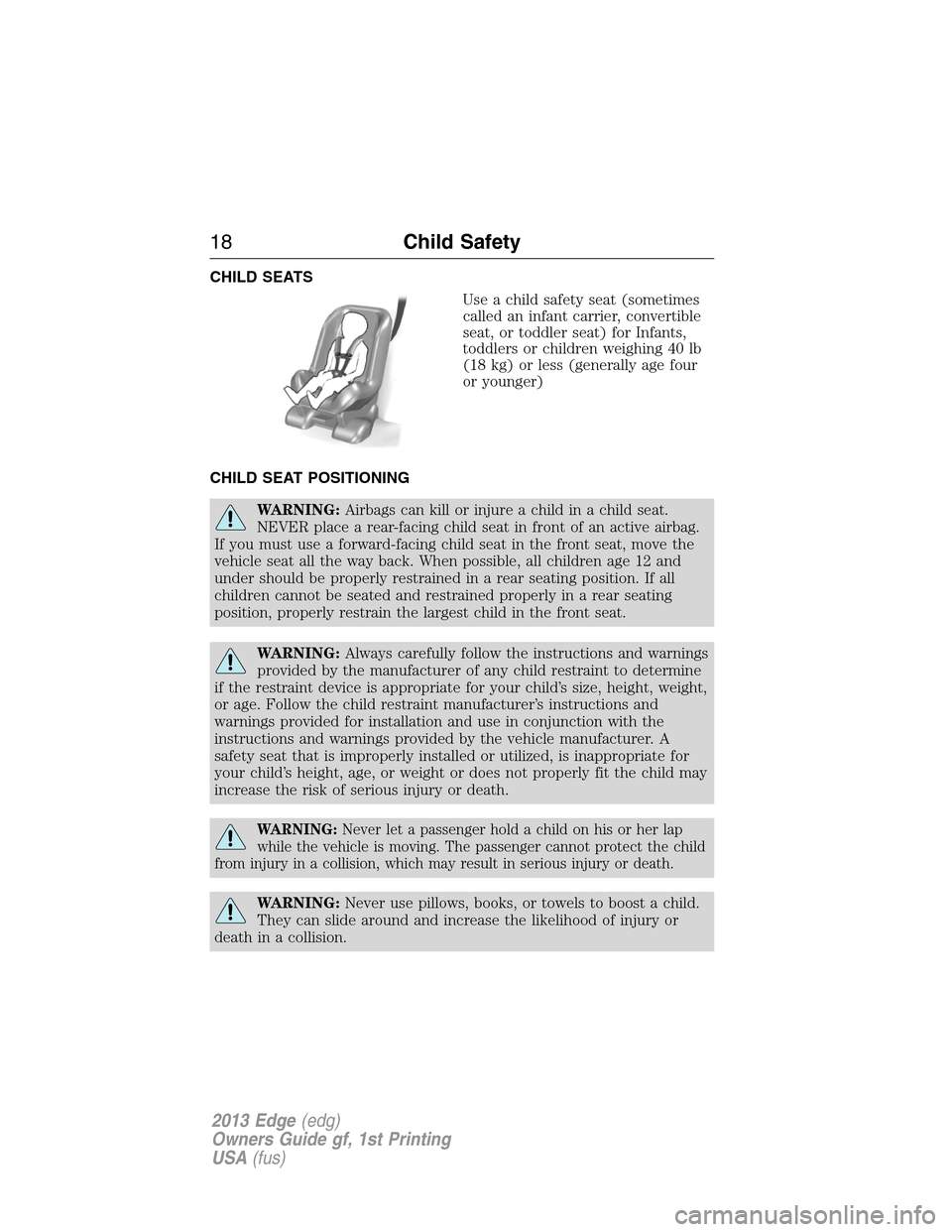
CHILD SEATS
Use a child safety seat (sometimes
called an infant carrier, convertible
seat, or toddler seat) for Infants,
toddlers or children weighing 40 lb
(18 kg) or less (generally age four
or younger)
CHILD SEAT POSITIONING
WARNING:Airbags can kill or injure a child in a child seat.
NEVER place a rear-facing child seat in front of an active airbag.
If you must use a forward-facing child seat in the front seat, move the
vehicle seat all the way back. When possible, all children age 12 and
under should be properly restrained in a rear seating position. If all
children cannot be seated and restrained properly in a rear seating
position, properly restrain the largest child in the front seat.
WARNING:Always carefully follow the instructions and warnings
provided by the manufacturer of any child restraint to determine
if the restraint device is appropriate for your child’s size, height, weight,
or age. Follow the child restraint manufacturer’s instructions and
warnings provided for installation and use in conjunction with the
instructions and warnings provided by the vehicle manufacturer. A
safety seat that is improperly installed or utilized, is inappropriate for
your child’s height, age, or weight or does not properly fit the child may
increase the risk of serious injury or death.
WARNING:Never let a passenger hold a child on his or her lap
while the vehicle is moving. The passenger cannot protect the child
from injury in a collision, which may result in serious injury or death.
WARNING:Never use pillows, books, or towels to boost a child.
They can slide around and increase the likelihood of injury or
death in a collision.
18Child Safety
2013 Edge(edg)
Owners Guide gf, 1st Printing
USA(fus)
Page 19 of 526

WARNING:Always restrain an unoccupied child seat or booster
seat. These objects may become projectiles in a collision or
sudden stop, which may increase the risk of serious injury.
WARNING:Never place, or allow a child to place, the shoulder
belt under a child’s arm or behind the back because it reduces
the protection for the upper part of the body and may increase the risk
of injury or death in a collision.
WARNING:Do not leave children, unreliable adults, or pets
unattended in your vehicle.
Restraint
TypeChild
WeightUse any attachment method as indicated
below by X
LATCH
(lower
anchors
and
top
tether
anchor)LATCH
(lower
anchors
only)Safety
belt
and
top
tether
anchorSafety
belt and
LATCH
(lower
anchors
and top
tether
anchor)Safety
belt
only
Rear
facing
child seatUp to
48 lb
(21 kg)XX
Forward
facing
child seatUp to
48 lb
(21 kg)XXX
Forward
facing
child seatOver
48 lb
(21 kg)XX
Note:The child seat must rest tightly against the vehicle seat. It may be
necessary to lift or remove the head restraint. See theSeatschapter for
information on head restraints.
Child Safety19
2013 Edge(edg)
Owners Guide gf, 1st Printing
USA(fus)
Page 20 of 526
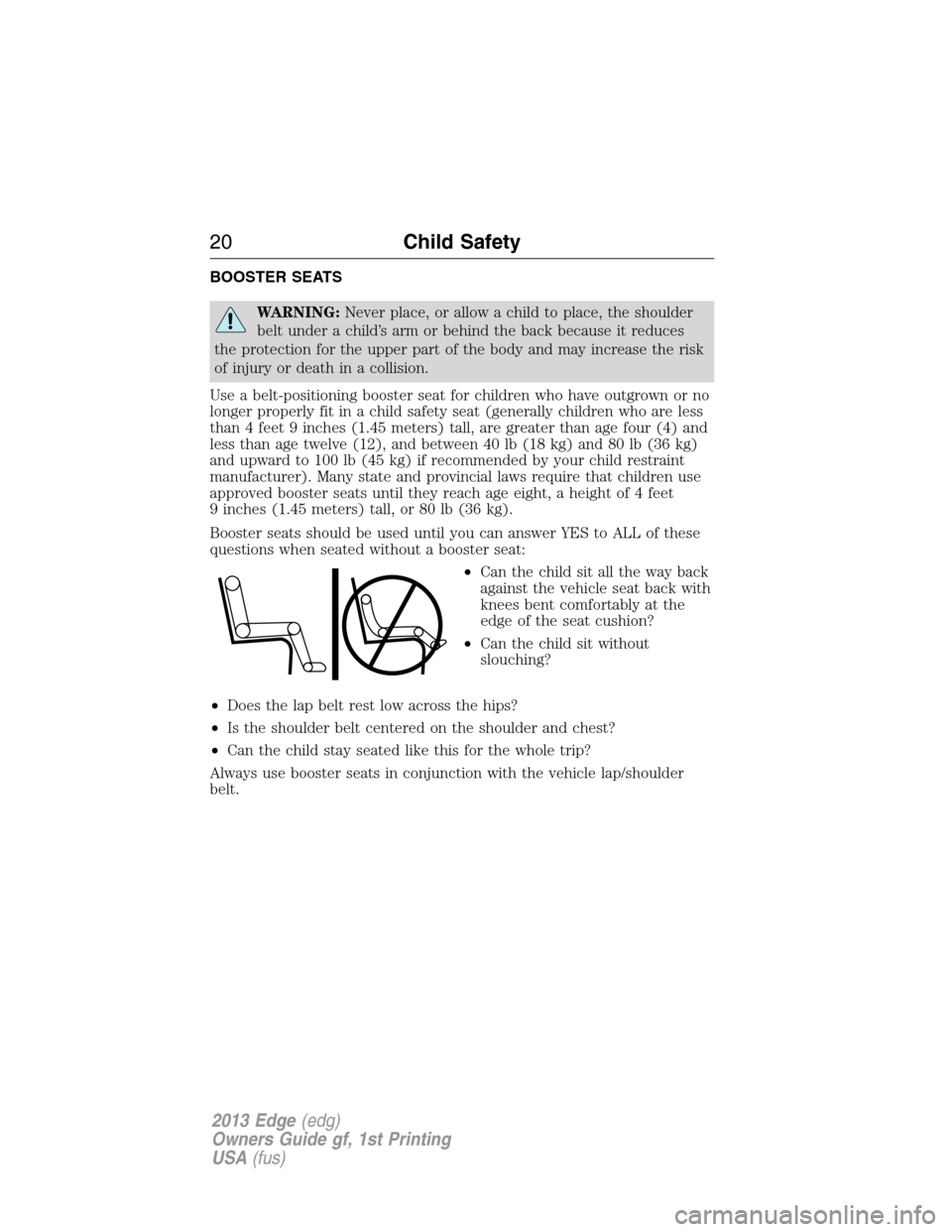
BOOSTER SEATS
WARNING:Never place, or allow a child to place, the shoulder
belt under a child’s arm or behind the back because it reduces
the protection for the upper part of the body and may increase the risk
of injury or death in a collision.
Use a belt-positioning booster seat for children who have outgrown or no
longer properly fit in a child safety seat (generally children who are less
than 4 feet 9 inches (1.45 meters) tall, are greater than age four (4) and
less than age twelve (12), and between 40 lb (18 kg) and 80 lb (36 kg)
and upward to 100 lb (45 kg) if recommended by your child restraint
manufacturer). Many state and provincial laws require that children use
approved booster seats until they reach age eight, a height of 4 feet
9 inches (1.45 meters) tall, or 80 lb (36 kg).
Booster seats should be used until you can answer YES to ALL of these
questions when seated without a booster seat:
•Can the child sit all the way back
against the vehicle seat back with
knees bent comfortably at the
edge of the seat cushion?
•Can the child sit without
slouching?
•Does the lap belt rest low across the hips?
•Is the shoulder belt centered on the shoulder and chest?
•Can the child stay seated like this for the whole trip?
Always use booster seats in conjunction with the vehicle lap/shoulder
belt.
20Child Safety
2013 Edge(edg)
Owners Guide gf, 1st Printing
USA(fus)
Page 21 of 526

Types of Booster Seats
•Backless booster seats
If your backless booster seat has a removable shield, remove the shield.
If a vehicle seating position has a low seat back or no head restraint, a
backless booster seat may place your child’s head (as measured at the
tops of the ears) above the top of the seat. In this case, move the
backless booster to another seating position with a higher seat back or
head restraint and lap/shoulder belts, or consider using a high back
booster seat.
•High back booster seats
If, with a backless booster seat, you cannot find a seating position that
adequately supports your child’s head, a high back booster seat would be
a better choice.
Child Safety21
2013 Edge(edg)
Owners Guide gf, 1st Printing
USA(fus)
Page 23 of 526
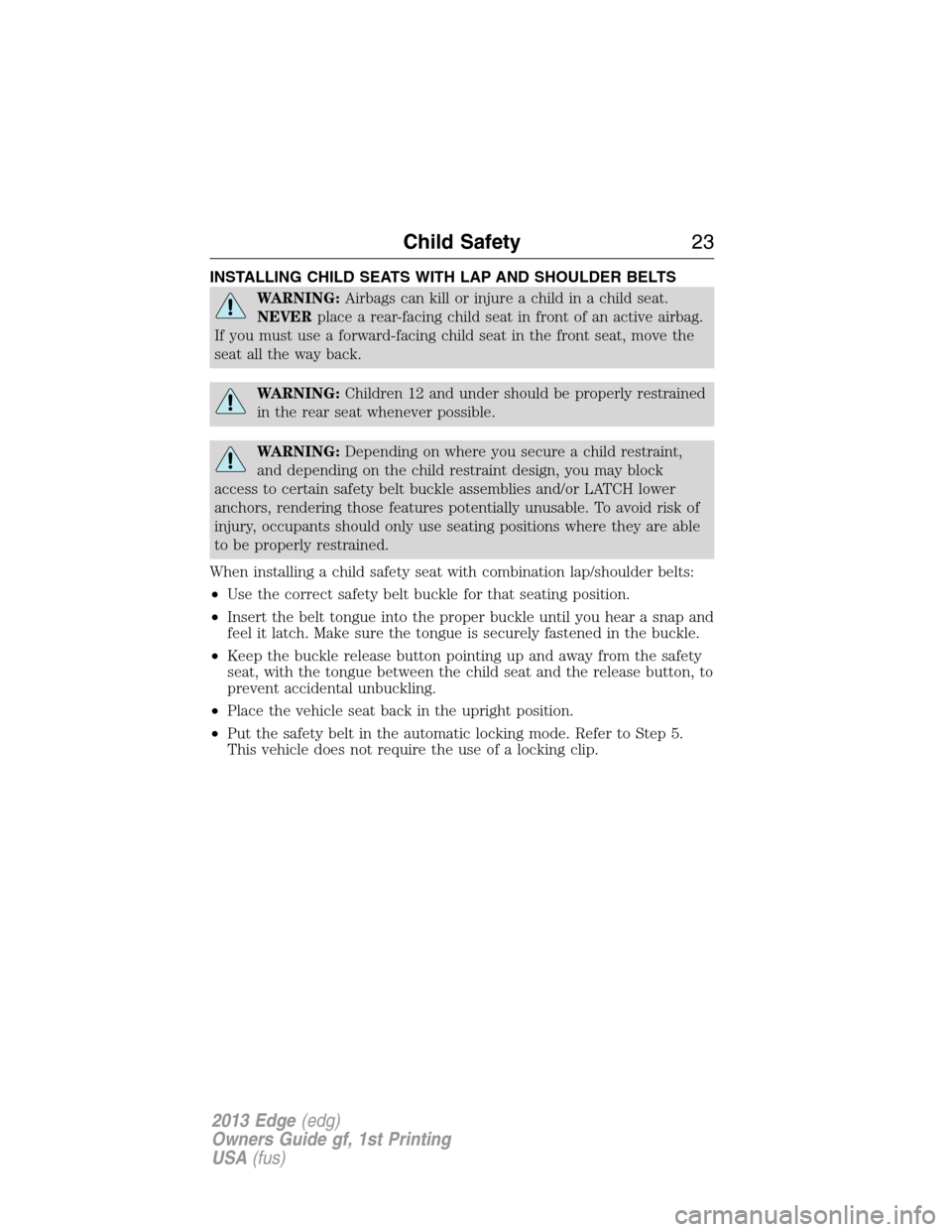
INSTALLING CHILD SEATS WITH LAP AND SHOULDER BELTS
WARNING:Airbags can kill or injure a child in a child seat.
NEVERplace a rear-facing child seat in front of an active airbag.
If you must use a forward-facing child seat in the front seat, move the
seat all the way back.
WARNING:Children 12 and under should be properly restrained
in the rear seat whenever possible.
WARNING:Depending on where you secure a child restraint,
and depending on the child restraint design, you may block
access to certain safety belt buckle assemblies and/or LATCH lower
anchors, rendering those features potentially unusable. To avoid risk of
injury, occupants should only use seating positions where they are able
to be properly restrained.
When installing a child safety seat with combination lap/shoulder belts:
•Use the correct safety belt buckle for that seating position.
•Insert the belt tongue into the proper buckle until you hear a snap and
feel it latch. Make sure the tongue is securely fastened in the buckle.
•Keep the buckle release button pointing up and away from the safety
seat, with the tongue between the child seat and the release button, to
prevent accidental unbuckling.
•Place the vehicle seat back in the upright position.
•Put the safety belt in the automatic locking mode. Refer to Step 5.
This vehicle does not require the use of a locking clip.
Child Safety23
2013 Edge(edg)
Owners Guide gf, 1st Printing
USA(fus)
Page 25 of 526

4. Insert the belt tongue into the
proper buckle (the buckle closest to
the direction the tongue is coming
from) for that seating position until
you hear a snap and feel the latch
engage. Make sure the tongue is
latched securely by pulling on it.
5. To put the retractor in the
automatic locking mode, grasp the
shoulder portion of the belt and pull
downward until all of the belt is
pulled out.
Note:The automatic locking mode is available on the front passenger
and rear seats. This vehicle does not require the use of a locking clip.
6. Allow the belt to retract to remove slack. The belt will click as it
retracts to indicate it is in the automatic locking mode.
7. Try to pull the belt out of the retractor to make sure the retractor is in
the automatic locking mode (you should not be able to pull more belt
out). If the retractor is not locked, unbuckle the belt and repeat Steps 5
and 6.
8. Remove remaining slack from the
belt. Force the seat down with extra
weight, e.g., by pressing down or
kneeling on the child restraint while
pulling up on the shoulder belt in
order to force slack from the belt.
Child Safety25
2013 Edge(edg)
Owners Guide gf, 1st Printing
USA(fus)
Page 26 of 526
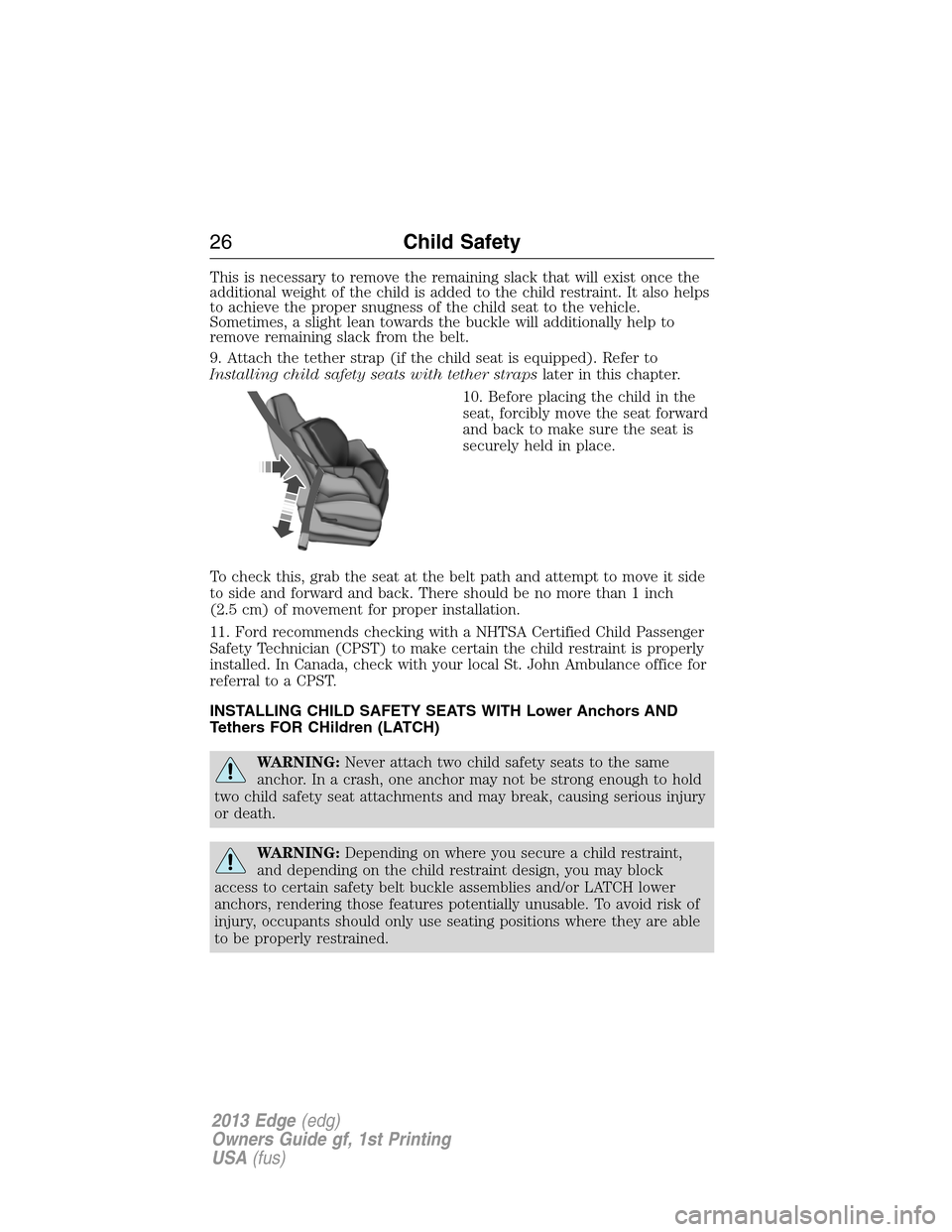
This is necessary to remove the remaining slack that will exist once the
additional weight of the child is added to the child restraint. It also helps
to achieve the proper snugness of the child seat to the vehicle.
Sometimes, a slight lean towards the buckle will additionally help to
remove remaining slack from the belt.
9. Attach the tether strap (if the child seat is equipped). Refer to
Installing child safety seats with tether strapslater in this chapter.
10. Before placing the child in the
seat, forcibly move the seat forward
and back to make sure the seat is
securely held in place.
To check this, grab the seat at the belt path and attempt to move it side
to side and forward and back. There should be no more than 1 inch
(2.5 cm) of movement for proper installation.
11. Ford recommends checking with a NHTSA Certified Child Passenger
Safety Technician (CPST) to make certain the child restraint is properly
installed. In Canada, check with your local St. John Ambulance office for
referral to a CPST.
INSTALLING CHILD SAFETY SEATS WITH Lower Anchors AND
Tethers FOR CHildren (LATCH)
WARNING:Never attach two child safety seats to the same
anchor. In a crash, one anchor may not be strong enough to hold
two child safety seat attachments and may break, causing serious injury
or death.
WARNING:Depending on where you secure a child restraint,
and depending on the child restraint design, you may block
access to certain safety belt buckle assemblies and/or LATCH lower
anchors, rendering those features potentially unusable. To avoid risk of
injury, occupants should only use seating positions where they are able
to be properly restrained.
26Child Safety
2013 Edge(edg)
Owners Guide gf, 1st Printing
USA(fus)